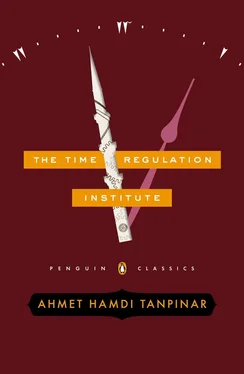But the fiction of the accident persisted. While Nevzat Hanım, mindful of his last letter, remained convinced that her husband had committed suicide, Salim Bey’s relatives were of the same opinion, as they too had received disturbing letters from the front. But these were quite different in tone; his complaints were of another kind: for in them he named the very source of his discontent.
To make matters worse, Salim’s mother, who had never loved her son, finding him spineless, tightfisted, and altogether useless, took advantage of his death and moved into the widow’s home. It nearly gave Nevzat Hanım a nervous breakdown. It wasn’t long before Zeynep Hanım — already terribly distraught — suspected that her husband, Tayfur Bey, was in love with Nevzat Hanım. Indeed hopelessly in love with Nevzat Hanım, Tayfur Bey was driven to murder his wife, Zeynep, in the hope of marrying Nevzat Hanım, and, stranger still, he confessed his crime to his beloved, in the belief that she would be left with no choice but to marry him. So poor Nevzat Hanım had to bear the burden of three deaths, of which one was her own father’s. We had always thought of Nevzat Hanım as a woman undone by the oppressive weight of her dreams, when in fact, beneath her quiet and well-meaning smile, she’d been struggling with a bitter fate. Though it was no fault of hers that people died, and even killed one another, she was burdened with the blame. If only she’d had the wherewithal to exercise her will, if only she’d been a bit more selfish or better at defending herself, she might have found the strength to cast off her burdens and find a modicum of freedom. No one understood why she’d not told the police the truth about Zeynep Hanım’s suicide.
When I first heard the news, I could not help but think of something my daughter had said to me, something I in fact mentioned earlier in these memoirs. When struggling to understand the madness that had descended on our home, she had mourned the fact that we were the kind of people who bore the blame. And that, I believe, is the crux of the matter. Nevzat Hanım was the kind of person who blamed herself for things she never did. Perhaps this came from her strict family upbringing or a childhood discolored by her elder sister’s jealousy. According to Sabriye Hanım, it had all begun with her sister staging a suicide attempt when they were young. At no point in her life had she been properly protected.
But more than anything else, she blamed herself for Salim’s death. It was his death that had drawn her to spiritualism. Murat was but a fiction, conjured up by a mother-in-law who did everything in her power to isolate the young widow. It was she who had answered the phone as Murat. In fact I’d been quite startled by her strident and oddly familiar voice on the occasion of our first meeting. Trumpets and foghorns were but remote figments of the auditory imagination next to this awesome voice. Throughout my life I have seen how lies are propped up, not only by those directly involved with them, but also by people with no particular reason to perpetuate them, which is why Sabriye Hanım’s explanation of the affair didn’t surprise me at all.
Later on, Sabriye Hanım, who was on intimate terms with Zeynep, joined forces with her, using her spinster wits to engineer a double blackmail that almost led to a police investigation, for she believed that there was indeed a serious relationship between Nevzat Hanım and Tayfur Bey: this served only to increase the stress and strain on the young widow. And then there was Cemal Bey.
But this much is clear: while Nevzat Hanım’s mother-in-law was still alive, Cemal Bey, Tayfur Bey, and Sabriye Hanım could never have gained easy access to Nevzat Hanım’s apartment. In fact the pseudoséances held at their home served no purpose other than to perpetuate the Murat story. But with the death of the old woman, all impediments were removed.
According to Sabriye Hanım, Cemal Bey was after Nevzat Hanım’s money. Cemal Bey had been thrown out of his own firm for embezzlement and had only barely managed to cover his debt by dipping into Selma Hanım’s inheritance; now he wanted to marry Nevzat Hanım for her money. And this being his last and only hope, he was relentless in pressing his claim.
Though Selma did not deny that money may have played a part in the affair, she also claimed that Cemal Bey had indeed fallen for Nevzat Hanım. “Cemal was a ladies’ man, and he always enjoyed a challenge. Most likely Nevzat’s monastic lifestyle had a certain appeal,” she said. In fact, and this again according to Selma, Cemal Bey had entered into a similar affair with Zeynep Hanım.
As for Tayfur Bey, he had never understood Nevzat Hanım. He’d assumed that his young wife had surrendered to Cemal’s unctuous entreaties. For, yes, indeed, there was a letter Tayfur Bey wrote before he died in which he made only the briefest mention of his love for his wife, devoting most of his energies to expressing his jealous and aggressive hatred for Cemal.
Nevzat Hanım’s sorry fate was to have been overwhelmed by these four men; just one of them would be enough to ruin any life.
IX
I assumed that the matter of personnel would be a tiring affair, not to mention their remuneration, and so I wanted to begin with as small a group as possible. Yet expansion was inevitable, given the exponential growth in the number of our own handpicked candidates, and in those recommended to us by our friends. We received several applications almost daily. The two office lines — Halit Ayarcı’s and my own — never stopped ringing. By the end of the first month, I came to understand how wrong I’d been to complain about not having enough friends or relations. I was amazed to discover just how large my family was. I was likewise impressed by the loyalty of old school friends and the continuing affection that my old neighborhood acquaintances still had for me. My quota had long since been exceeded in the applicant ledger. Most were people who had been sensitive enough to stay at arm’s length during the years when my spirits had been so dampened by misfortune; now they had entered into an all-out war as they struggled to give me the chance to prove that I too felt compassion for my friends and relatives.
When I asked Halit Ayarcı what he thought I should do in the face of this barrage, he gave me the following answer:
“My dear Hayri Irdal, in matters such as these there are two methods: either you put the whole affair out of your mind or you separate the applicants into prearranged categories and then choose one from each group. As I’m in the same boat, why don’t we ponder the two options together? If we agree to leave the affair to fate and fortune, we’ll have no choice but to draw lots. But I imagine the result would not necessarily turn out in our favor. And if word ever got out that we’d availed ourselves of such a method, then we’d almost certainly meet with stiff criticism.”
“So shall we create categories!”
“Yes, but what will we use as our criteria?”
“We’ll select those with experience. For example, those people who have more or less worked for a certain period of time in a particular field.”
“Oh no, never that. It seems you haven’t understood the true meaning of ‘experience.’ To be experienced means to be run down, frozen at some fixed point, and stuck with stagnant ideas. Such people are of no use to us.”
There was no other choice but to choose from the inexperienced.
“Well then, we’ll choose those without experience,” I said.
Halit Ayarcı paused for a moment. He was scrutinizing a new chart on his office wall. Taking me by the arm, he pulled me over to it.
“I designed this chart as part of a study evaluating the love children have for watches and clocks. But certain points don’t seem entirely right. This dark-blue column should have been assigned to the children of literate families! But I assigned it to timepieces given as gifts. No, we’ll have to move them to this smaller yellow column here… Could you kindly have this corrected for me?”
Читать дальше












